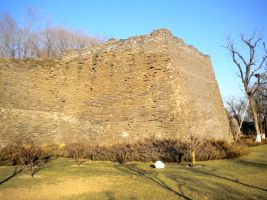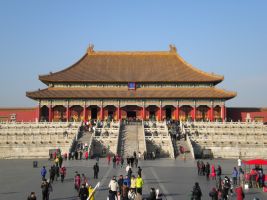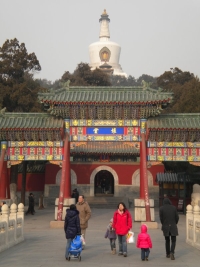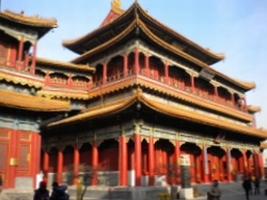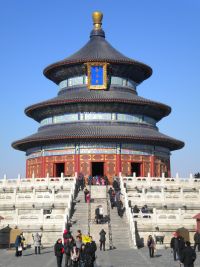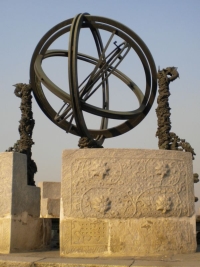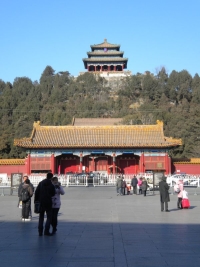Beijing, Tianjin, Zhengzhou 2010-2011
From the end of December 2010 we returned for my fifth trip to China, spending three amazing weeks visiting China’s capital Beijing as well as Tianjin, located south of Beijing, and Zhengzhou in central China.
This is the story of my trip – while reading this story you can at the same time view the Photo Album from this trip (opens in new window/tab).
Introduction
Tian’anmen Square and the Imperial Palace (also known as the Forbidden City) were the first of Beijing’s numerous significant attractions that I visited after arriving in China’s capital on 27 December. In the following days we took a hutong tour including a visit to Prince Gong Mansion, visited my friend’s former university, took a day trip to the city of Tianjin, explored Beihai Park, and enjoyed Beijing’s outstanding shopping and dining.
On 4 January we travelled by train from Beijing to Zhengzhou, capital of Henan province, where we enjoyed spectacular views over Zhengzhou from a revolving restaurant and I visited the nationally significant Henan Museum.
On 9 January I returned to Beijing, and for the remainder of the trip visited more significant attractions – Yonghegong Lama Temple, Temple of Heaven, Beijing Ancient Observatory, the Summer Palace and Jingshan Park – as well as making a return visit to the Imperial Palace.
Being winter the weather was quite cold throughout the trip, with the daily temperatures in Beijing ranging from overnight minimums of around minus 10 to 15 degrees Celsius to maximums of around minus 3 to zero degrees Celsius. However the only time I found the cold to be very noticeable was on the few days where there was a strong northerly wind blowing. I quickly learnt to plan my touring around the China Meteorological Administration weather forecast so that I was mainly inside or in sheltered locations on the windy days.
Chongwenmen and Beijing’s ancient city wall
For our first period in Beijing we stayed at Chongwenmen, which is in the south-eastern corner of the inner city. Chongwenmen means “Chongwen gate”. Chongwen gate was one of the gates in Beijing’s ancient city wall and construction of the gate commenced in 1436 in the Ming Dynasty. Chongwen gate no longer stands, however leading east from Chongwenmen a 1.5 km section of the ancient city wall has been protected in the Ming City Wall Site Park.
Ming City Wall Site Park (Galleries)
About 1.5 km west of Chongwenmen another of the gates, Zhenyangmen (Zhenyang gate) still stands at the southern end of Tian’anmen Square. Zhenyangmen is commonly known as Qianmen (front door) and is the highest and most magnificent city gate in Beijing.
Chongwenmen now features major department stores and numerous restaurants as well as a subway station accessing two lines of Beijing’s extensive, efficient and expanding subway network.
Tian’anmen Square and Imperial Palace
Tian’anmen Square takes its name from the Tian’anmen gate (Gate of Heavenly Peace) to the Imperial Palace at the north of the square. Under clear blue skies I joined the many people who were in the square visiting the Monument to the People’s Heroes and the Mausoleum of Mao Zedong, and then commenced an exploration of the Imperial Palace.
Tian’anmen (Galleries)
I had seen photographs of the Imperial Palace (Forbidden City), but pictures can’t convey the extraordinary scale and grandeur of this vast complex.
The World Heritage listed Imperial Palace is located in the centre of inner city Beijing, Construction began in 1406, and it was the palace for 24 emperors through the Ming and then Qing Dynasties. It has many halls and pavilions, and is divided into two main areas – the Inner Court and Outer Court. There are an incredible 8,700 rooms in the Imperial Palace.
After passing through Tian’anmen gate I entered the Imperial Palace through the massive Meridian Gate, which is the main entrance gate. I then detoured to the right to visit the Hall of Ceramics, where there are many beautiful historic ceramics on display. It was here that I came across the first of the many friendly cats that are allowed to live freely in the Imperial Palace (and many of Beijing’s other significant sites) as a natural form of pest control.
Coming back to the main north-south axis of the Imperial Palace I crossed the marble bridges over the Jade Ribbon River, which runs for 2km through the palace complex.
I then progressively headed north exploring the grand central buildings of the palace – the Gate of Supreme Harmony, Hall of Supreme Harmony, Hall of Middle Harmony, Hall of Preserving Harmony, Gate of Heavenly Purity, Palace of Heavenly Purity, Hall of Union and Peace, and Palace of Earthly Tranquility. The Palace of Heavenly Purity, Hall of Union and Peace, and Palace of Earthly Tranquility make up the Inner Court of the palace.
Imperial Palace (Galleries)
Both the interiors and exteriors of these buildings feature intricate and beautifully coloured decoration, as well as many ancient treasures. The Hall of Supreme Harmony is the most magnificent building in the Imperial Palace, and the building that most commonly appears in photographs of the palace.
After leaving the Inner Court I came to the Imperial Garden which is at the centre of the very northern end of the Imperial Palace. The Imperial Garden was a place of amusement for emperors, empresses and concubines, with pavilions, ancient trees, bamboo gardens, rocks and artificial hills.
I then explored the Six Western Palaces and Six Eastern Palaces, and then the Gallery of Treasures which comprises further gates, halls and a palace with many ancient treasures on display. The Imperial Palace is not just one palace – it is an extraordinary complex of many grand gates, palaces, and halls.
Near the entrance of the Gallery of Treasures was the large Nine Dragon Screen, one of only three such large Nine-Dragon Screens in China (a few days later I was to see another of the three in Beihai Park), and within a garden in the Six Eastern Palaces is a well where Concubine Zhen was drowned on the order of Empress Dowager Cixi.
A full day exploring the Imperial Palace then came to an end as closing time sadly arrived. I had still not seen everything, in particular the Hall of Clocks, so decided I would return for a second visit later in the trip.
Hutong tour and Prince Gong Mansion
The hutongs are Beijing’s ancient narrow lanes lined with traditional courtyard houses. The hutongs we toured are located directly north of the Imperial Palace.
We travelled by subway from Chongwenmen Station to Guloudajie Station where we hired cycle rickshaws for the tour. The open cycle rickshaws were probably not the most sensible transport choice on what was the coldest and windiest day during our time in Beijing, but they did allow us a great view of the hutongs and the riders were very knowledgeable about hutong history and significant sites.
The sites we passed included the ancient Drum and Bell Towers which align exactly with the south-north axis of the Imperial Palace (something I only realised later when taking in the view of Beijing from Jingshan Park).
Prince Gong Mansion (Galleries)
Our final destination on the hutong tour was Prince Gong Mansion, which is one of Beijing’s largest and best-preserved royal mansions. It has numerous buildings and courtyards, with exquisite grandeur reminiscent of the Imperial Palace. At the northern end of the mansion complex is a large splendid garden with a lake, ponds, pavilions and artificial hills. We returned to Chongwenmen by bus.
Minzu University
On another day we travelled to Minzu University in Beijing’s Haidan District, where one of my friends had completed undergraduate studies. It was his first visit back to the campus since graduating in 2004, and was an emotional journey for him that brought back many good memories.
Minzu University is the top university in China that is specifically for ethnic minorities, and it aims to be one of the best universities of its kind in the world. The diverse student population also encompasses Han Chinese, China’s largest ethnic group, including my friend. The first campus buildings were constructed in the 1950’s and have a distinctive style based on Beijing’s ancient architecture.
The ethnic diversity of the university means that dining options from all over China can be found lining a nearby street. Here we met a Professor who was a friend of my friend, and she recommended a Dai restaurant where we had an excellent lunch. The Dai are an ethnic minority from southern China.
While we were at Minzu University and walking to the nearby Dai restaurant we experienced a few flurries of snow. Before the trip we had wondered if we would see Beijing in snow, but these brief flurries were the only snow we experienced. It wasn’t until more than three weeks after the end of our trip that Beijing received snowfalls, breaking the longest snow-free winter for 60 years.
Tianjin
On 2 January we took a day trip to the city of Tianjin, famous for its great food and European colonial architecture. The 130km journey from Beijing to Tianjin took only 30 minutes on the new high speed rail service which reached a speed of 325 km/h. China has 17,000 km of high speed rail lines under construction across the country, and metro rail networks are being built in many cities.
Beihai Park
Beijing’s beautiful Beihai Park was our destination on 3 January. Located north-west of the Imperial Palace in the centre of Beijing, Beihai Park is one of the oldest, largest and best preserved ancient imperial gardens in China with a history of about 1,000 years.
After entering the park we explored the elegant Hall of Spiritual Peace which includes the beautiful Clear Mirror Studio, and then made our way to the shore of the lake that makes up over half of the area of Beihai Park. We wandered along the lake edge exploring halls, pavilions and other features including the Five-Dragon Pavilions and the exquisitely decorated Xiao Xi Tian. Adjacent to the Hall of Spiritual Peace is a Nine-Dragon Screen, the second I had seen on this trip and another of three large Nine-Dragon Screens in China (the third is located in Datong in Shanxi Province).
After making our way around the lake from the north-west to south-east of the park we came to Qionghua (Jade Flowery) Islet. On the peak of the islet is the majestic White Dagoba, a major landmark in Beihai Park. We completed our visit to Beihai Park with an exploration of the circular Tuancheng City (City of Harmony).
Beihai Park (Galleries)
Shopping and dining
Dining out is a highlight of any trip to China, and Beijing is a dining paradise with a wide range of excellent food options on offer.
We dined in several Chongwenmen restaurants in our time there, and found ourselves returning several times to a group of excellent restaurants at No. 3 East Damochang Street. There we dined at Da Wan Ju (宏状元) Chinese Homestyle and Dumplings, Hong Zhuang Yuan (大碗居) Rice Porridge, and Laocheji Malaxiangguo (老车记麻辣香锅) Sichuan. As well as a wide range of sweet and savoury rice porridge, Hong Zhuang Yuan featured an excellent range of tasty savoury pasty dishes. Laocheji Malaxiangguo features a great variation of hot pot where the chef cooks the ingredients and sauce of your choice and it comes to your table in a huge steaming bowl for the table to share. No. 3 East Damochang Street also includes a Qing Feng Steamed Bun Shop (庆丰包子铺). We didn’t get a chance to dine at this particular shop, however we enjoyed lunch at a Qing Feng Steamed Bun Shop near Prince Gong Mansion at the end of our hutong tour.
We also dined at the second Da Wan Ju restaurant at nearby No. 56 Dongxinglong Street, Chongwenmen where I was able to try the famous Beijing Roast Duck, which was delicious.
Close by to these Chongwenmen restaurants is the New World Shopping Centre which comprises three separate buildings, two of which are joined with a pedestrian link. We shopped here numerous times, including regular visits to the large basement supermarket.
One evening we walked north from Chongwenmen to Wangfujing, crossing Chang’an Avenue on the way. Wangfujing is one of China’s most significant pedestrian streets and one of Beijing’s best known shopping areas. There are numerous contemporary shopping malls in the area including the massive Malls at Oriental Plaza, and there is also a night market which includes a lane of street food outlets. Chang’an Avenue is a major road that runs east-west across the Beijing city centre passing directly in front of Tian’anmen.
Zhengzhou
On 4 January we travelled by train from Beijing to Zhengzhou, capital of Henan province. We boarded the train at the massive Beijing West Railway Station, one of the largest railway stations in Asia. The train journey took just over 5 hours to travel a distance of about 800 km, and while not high speed rail it was still a fast and efficient service in a very comfortable near-new train. The high speed rail line between Beijing and Zhengzhou is currently under construction and when completed the travel time between the two cities will be reduced significantly.
That evening we enjoyed the night view of Zhengzhou from the city’s only revolving restaurant which is on the top floor of the Zhengzhou Guangdong Hotel where we were staying. The view included nearby Erqi Square and Erqi Tower, a major landmark in central Zhengzhou, as well as the remains of the ancient city wall. The hotel also fronts the bustling Dehua Street Pedestrian Shopping Mall, established in 1905, where we shopped in the many clothing brand stores lining the street.
Revolving restaurant (Galleries)
The Zhengzhou Guangdong Hotel is part of the Guangdong Hotel chain, a Chinese brand. I found the quality and service at the Zhengzhou Guangdong Hotel to be much better than that at the two other hotels we stayed in during this trip which were both from international chains based outside China. I think many overseas visitors to China would choose international brands because they are familiar with these brands and their websites. However many outstanding Chinese brands and hotels can be just as easily booked through the Chinese travel website Ctrip. We used Ctrip to book the Zhengzhou Guangdong Hotel and have also used it for previous trips. Ctrip provides over 50 million registered members with comprehensive services including hotel reservations, flight ticketing, package tours and corporate travel management.
Henan Museum
While in Zhengzhou I visited the nationally significant Henan Museum. One of the oldest museums in China, the Henan Museum moved into its present distinctive building in 1998. At present the museum has a collection of more than 130,000 cultural relics, of which more than 5,000 pieces are highly significant treasures.
At the Henan Museum I was able to learn more about the history of Henan Province’s ancient capitals – Zhengzhou, Kaifeng, Luoyang and Anyang – after having visited all of them except Anyang. I was also able to find out more about the history of significant heritage sites in the province such as the Longmen Grottoes, which I had also previously visited.
After exploring the fascinating treasures of the Henan Museum and enjoying the hospitality of Zhengzhou’s very friendly people I returned to Beijing by train on 9 January.
Beijing Dongzhimen
For the second period in Beijing I stayed in Dongzhimen, which is located east of the inner city near the Beijing Worker’s Stadium and Gymnasium and Beijing’s embassy district. Like Chongwenmen where we stayed earlier in the trip, Dongzhimen was previously the location of an ancient city gate. It also has a subway station that accesses two subway lines as well as the Airport Express train service, and many excellent dining options.
In this part of the trip I visited more of Beijing’s attractions – Yonghegong Lama Temple, Temple of Heaven, Beijing Ancient Observatory, the Summer Palace and Jingshan Park – as well as making a return visit to the Imperial Palace. I also visited Xidan, another major shopping area in Beijing, and made a return trip to the Wangfujing pedestrian shopping street.
Yonghegong Lama Temple
Yonghegong Lama Temple, the largest lamasery in Beijing, was built in 1694 as the residence of Prince Yong of the Qing Dynasty. After the prince came to the throne as Emperor Yongzheng he in 1725 changed his old residence into a temporary dwelling palace called “Yonghegong” meaning palace of harmony and peace. In 1744 his successor Emperor Qianlong changed the palace into a lama temple.
The temple pavilions feature beautiful intricate decoration, and in the pavilions I saw many Buddhist statues, paintings and relics including a breathtaking 18-metre high Buddha carved from one piece of white sandalwood. The temple is located in the north-eastern part of the Beijing central city area, adjacent to Yonghegong subway station.
Yonghegong Lama Temple (Galleries)
Temple of Heaven
I accessed the World Heritage listed Temple of Heaven from the East Gate, which is located adjacent to the Tiantandongmen Station. After walking through the gate I was immediately struck by the large size of the area of parkland in which the Temple of Heaven is located. Covering an area of 273 hectares, the parkland features Ancient Cypress Woods with some trees up to 800 years old.
Passing the Seven-Star Stones, I made my way to the Hall of Prayer for Good Harvests that I could see rising above the tree canopy in the distance. This magnificent building was first built in 1420 in a rectangular shape, was rebuilt with a circular shape in 1545, and then reconstructed in 1751 in the Qing Dynasty. The hall was exclusively used to pray for good harvests in early spring (in January). Adjacent to the Hall of Prayer for Good Harvests is the Imperial Hall of Heaven.
From the Hall of Prayer for Good Harvests I walked through the Gate of Prayer for Good Harvests and then along the Danbi Bridge. The 360 metre long Danbi Bridge is a raised way connecting the Altar of Prayer for Grains, where the Hall of Prayer for Good Harvests is the main structure, with the Altar of Circular Mound to the south. Danbi Bridge is slightly higher at its northern end to give the impression of walking on a road rising to Heaven when walking towards the Hall of Prayer for Good Harvests.
Temple of Heaven (Galleries)
I explored the Altar of Circular Mound and its adjacent buildings. The Altar of Circular Mound is an open circular platform located on top of three terraces of marble stones. It is the main altar of the Temple of Heaven, where emperors would pray to Heaven for rain and good harvests. In the centre of the Altar of Circular Mound is the Heavenly Centre Stone, where if someone speaks, their voice is amplified by the acoustics of the mound balustrades. This was thought to help prayers reach heaven.
Adjacent to the Altar of Circular Mound are the Imperial Vault of Heaven and East and West Annex Halls. These buildings are surrounded by the circular Echo Wall. If someone speaks next to the inner surface of the Echo wall their voice will be transmitted clearly by the wall’s excellent acoustics to someone standing next to a different part of the wall. The majestic circular Imperial Vault of Heaven was where the tablets used in prayer ceremonies were stored.
After leaving the Altar of Circular Mound I took a long walk through the beautiful and tranquil ancient Cypress woods. I walked right around the southern and then western parts of the Temple of Heaven parkland, passing on the way the South Gate where there is a World Heritage marker.
On the western side of the parkland I came to the Fasting Palace, where emperors would exercise abstinence for three days before conducting sacrificial rites at the temple. The Fasting Palace is surrounded by a moat, and the main building of the palace is the Beamless Hall. The Fasting Palace was almost deserted, as most visitors to the Temple of Heaven only go to the central area where there is the Altar of Circular Mound, Danbi Bridge and Hall of Prayer for Good Harvests. However the Fasting Palace is well worth a visit with interesting displays in the Beamless Hall, restful courtyard gardens and other interesting features.
From the Fasting Palace I continued my very enjoyable walk around the Temple of Heaven parkland, walking around the northern part of the parkland past the Altar of Prayer for Grains and back to the East Gate finishing a very enjoyable day.
Beijing Ancient Observatory
The Beijing Ancient Observatory was first established in 1442 in the Ming Dynasty, and is one of the oldest and longest operating astronomical observatories in the world. It is located in the south-eastern part of the Beijing central city area and easily accessed from the directly adjacent Jianguomen subway station.
Ancient Observatory (Galleries)
I explored the observatory grounds and buildings where there are good interpretive displays on ancient astronomy, the history of the observatory, and the functions and operation of ancient astronomical equipment. I then climbed the ancient stairs to the observatory platform, located on top of a tower that was part of the old city wall, where there are several fascinating well-preserved pieces of historic astronomical equipment.
Summer Palace
A journey on subway lines 2 and 4 took me from Dongzhimen station, near where I was staying, to Beigongmen station in Beijing’s north-west suburbs. “Bei Gong Men” means “North Palace Gate”, with the station located right next to the North Palace Gate of the World Heritage listed Summer Palace. Entering the gate I followed the steep meandering paths past ancient trees and historic pavilions to the crest of Longevity Hill where a spectacular view over the frozen Kunming Lake opened up.
The Summer Palace was built by Emperor Qianlong in 1750 to celebrate his mother’s birthday. Kunming Lake has a causeway imitating West Lake in Hangzhou. I walked out on the causeway for the stunning view back across the lake to the Tower of the Fragrance of the Buddha which dominates Longevity Hill. I then walked back and strolled along the Long Corridor, an open-sided walkway with ornate roof and ceiling that spans the edge of the lake at the foot of Longevity Hill. On the ornate ceiling of the walkway there are an incredible 14,000 paintings.
Summer Palace (Galleries)
I left the Long Corridor and ascended the steep stairs to the beautifully decorated Tower of the Fragrance of the Buddha which is a large three-storied octagonal structure with four sets of eaves. There were stunning views over the Summer Palace. After this I descended to the lake edge again to explore the halls and gardens in the eastern part of the Summer Palace, and then walked back to the North Palace Gate for my return journey. The Summer Place was, like the Imperial Palace, a highlight of this trip.
Jingshan Park
Jingshan Park is located in central Beijing and covers an area of 230,000 square metres. The dominant feature of the park is a hill with the Wanchun Pavilion on its peak. After a short steep climb I enjoyed magnificent views over Beijing in all directions, including of the directly adjacent Imperial Palace to the south, Beihai Park to the north-west and Drum and Bell Towers to the north. Built in the Liao and Jin Dynasties, Jingshan has a history of almost one thousand years. The artificial hill was constructed in the 15th century from earth excavated to create the moats for the Imperial Palace.
After enjoying the panoramic views from Jingshan Park I returned to the adjacent Imperial Palace, and headed straight for the Hall of Clocks that I had run out of time to see on my first visit earlier in the holiday. I was glad that I returned as the Hall of Clocks features an amazing array of ornate historic timepieces from small watches to clocks that are several metres high.
After the Hall of Clocks I went to one of the many shops that are throughout the Imperial Palace to buy gifts for family members and browse the excellent range of books about Chinese history and culture. I bought a fascinating book about Chinese houses. I then made my way through the halls, palaces and pavilions of the Imperial Palace from north to south and exited at Tian’anmen.
Jingshan Park (Galleries)
Another great China trip wraps up
After three amazing weeks I sadly left Beijing. On a future trip I will explore the attractions outside the Beijing city area including the Great Wall and Ming Tombs. This time we flew to and from China with Air China, the national flag carrier, and their service was excellent. Already I miss the vibrant daily modern life, friendly Chinese people, rich ancient culture, and the amazing diversity of food – hopefully the next visit won’t be too long away!
For the stories and pictures from my other trips to China see My China Trips and the Galleries.
